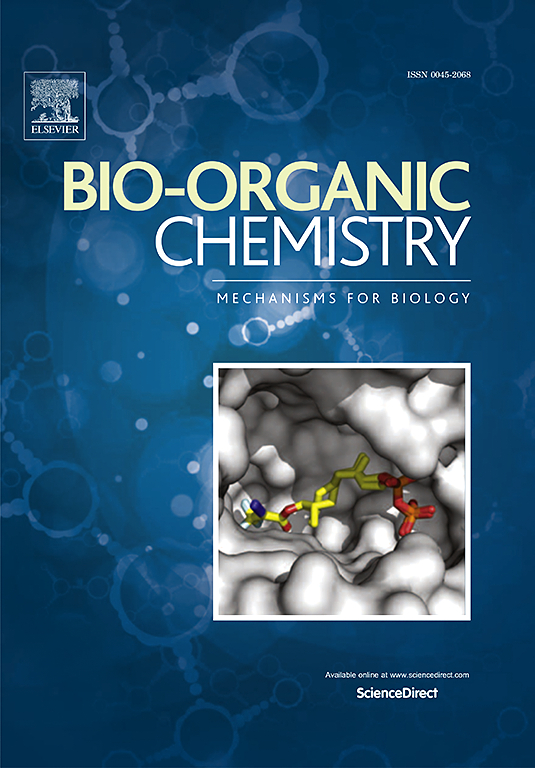Optimization of Aminoindazole derivatives as highly selective covalent inhibitors for wild-type and mutant FGFR4
IF 4.5
2区 医学
Q1 BIOCHEMISTRY & MOLECULAR BIOLOGY
引用次数: 0
Abstract
The Fibroblast growth factor receptor 4 (FGFR4) has emerged as a potential oncogenic driver in hepatocellular carcinoma (HCC), primarily due to aberrations in the FGFR4-FGF19 signaling axis. Although the FGFR4-selective inhibitors have been reported, none have received approval. Further, the clinical acquired resistance caused by FGFR4 mutations has become an unmet clinical need for cancer therapy. In this study, we designed and synthesized a series of 3-amido-1H-indazole-based FGFR4 irreversible inhibitors, targeting both wild-type FGFR4 and the gatekeeper and molecular brake mutants. The representative compound, 48c, exhibited potent inhibitory activity against FGFR4WT kinase (IC50 = 2.9 nM) and picomolar activity against FGFR4WT, FGFR4V550L, and FGFR4V550M-driven Ba/F3 cell lines (IC50 < 0.1, 0.3, and 0.3 nM, respectively). 48c exhibited high selectivity across a panel of 66 kinases harboring a cysteine at the hinge region, highlighting its potential as a promising therapeutic candidate for overcoming resistance in FGFR4-associated tumors.

氨基吲哚唑衍生物作为野生型和突变型FGFR4高选择性共价抑制剂的优化
成纤维细胞生长因子受体4 (FGFR4)已成为肝细胞癌(HCC)的潜在致癌驱动因素,主要是由于FGFR4- fgf19信号轴的畸变。尽管fgfr4选择性抑制剂已被报道,但没有一个获得批准。此外,FGFR4突变引起的临床获得性耐药已成为癌症治疗的未满足临床需求。在本研究中,我们设计并合成了一系列基于3-氨基- 1h -吲唑的FGFR4不可逆抑制剂,靶向野生型FGFR4以及守门人和分子制动突变体。代表性化合物48c对FGFR4WT激酶具有强抑制活性(IC50 = 2.9 nM),对FGFR4WT、FGFR4V550L和fgfr4v550m驱动的Ba/F3细胞系具有皮摩尔活性(IC50 <;分别为0.1、0.3和0.3 nM)。48c在铰链区域含有半胱氨酸的66种激酶中表现出高选择性,突出了其作为克服fgfr4相关肿瘤耐药的有希望的治疗候选药物的潜力。
本文章由计算机程序翻译,如有差异,请以英文原文为准。
求助全文
约1分钟内获得全文
求助全文
来源期刊

Bioorganic Chemistry
生物-生化与分子生物学
CiteScore
9.70
自引率
3.90%
发文量
679
审稿时长
31 days
期刊介绍:
Bioorganic Chemistry publishes research that addresses biological questions at the molecular level, using organic chemistry and principles of physical organic chemistry. The scope of the journal covers a range of topics at the organic chemistry-biology interface, including: enzyme catalysis, biotransformation and enzyme inhibition; nucleic acids chemistry; medicinal chemistry; natural product chemistry, natural product synthesis and natural product biosynthesis; antimicrobial agents; lipid and peptide chemistry; biophysical chemistry; biological probes; bio-orthogonal chemistry and biomimetic chemistry.
For manuscripts dealing with synthetic bioactive compounds, the Journal requires that the molecular target of the compounds described must be known, and must be demonstrated experimentally in the manuscript. For studies involving natural products, if the molecular target is unknown, some data beyond simple cell-based toxicity studies to provide insight into the mechanism of action is required. Studies supported by molecular docking are welcome, but must be supported by experimental data. The Journal does not consider manuscripts that are purely theoretical or computational in nature.
The Journal publishes regular articles, short communications and reviews. Reviews are normally invited by Editors or Editorial Board members. Authors of unsolicited reviews should first contact an Editor or Editorial Board member to determine whether the proposed article is within the scope of the Journal.
 求助内容:
求助内容: 应助结果提醒方式:
应助结果提醒方式:


